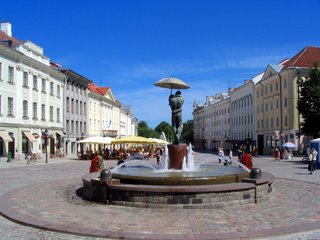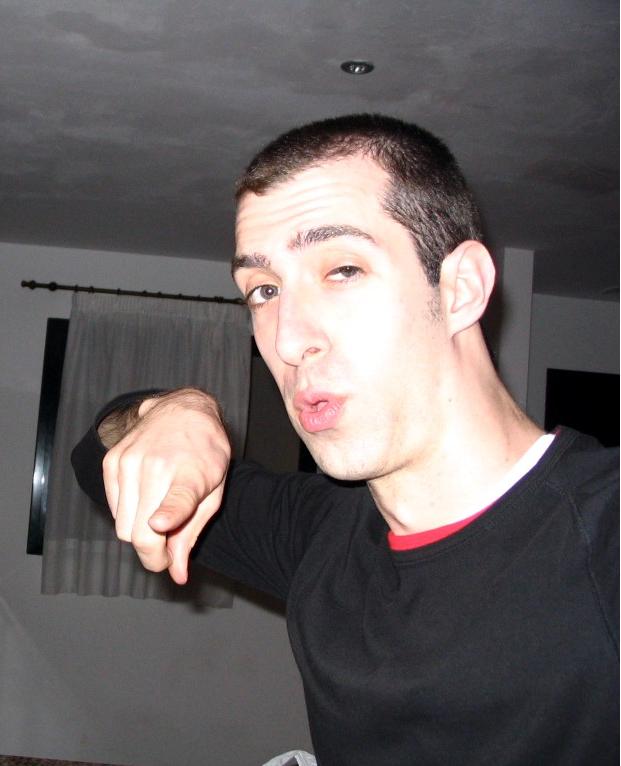Laulupidu!
 Yesterday, I attended the 50th Anniversary of The Baltic Students Song and Dance Festival in Tartu, Estonia. It was the 15th Festival of its kind since 1956. Lets have a quick History lesson, shall we?
Yesterday, I attended the 50th Anniversary of The Baltic Students Song and Dance Festival in Tartu, Estonia. It was the 15th Festival of its kind since 1956. Lets have a quick History lesson, shall we?Tartu held the first Student Song Festival in 1956, also in Tartu. Of course Lithuania and Latvia were invited, but other countries such as Moldovia, Ukraine, Belarus, and Russia took part as well. Nowadays, the festival is for the three Baltic States of Estonia, Latvia, and Lithuania. The festival is rotated between the three countries. Next time, Lithuania will host. The Song Festival Tradition is crucial to Baltic history and culture, especially that of Estonia. Song Festivals have been tradition here for over 100 yrs, the first song festival being held in 1869 in Tartu. Festivals were held every couple of years, both nationally as well as internationally. Festivals today are held for Mixed Choirs, Men's Choirs, Children's Choirs, Dance, Student Choirs, as well as other arrangments.
Song Festivals were not only of cultural importance, but political importance as well. During the Soviet period, photos of song festivals depicted large communist banners, pictures of Stalin, and other Soviet propoganda. This propoganda had the effect of displaying happiness and prosperity of people under the yolk of Soviet oppression. During this period, repetoire consisted mainly of music in Russian, either by Russian composers, or Estonian's writing in Russian. As the Cold War thawed, however, Estonian national tunes as well as Western "Masterpieces" slowly crept into the mix. The culmination of the political power of Song Festivals occured in 1988, when Estonia had what is reffered to as their "Singing Revolution". During this Festival, hundreds of thousands of people gathered in Tallinn's Song Festival Grounds to make political statements and sing National songs in defiance of their oppressors.
Today, Song Festivals are a celebration of culture, a show of solidarity among the Baltic States and the International community, and a reminder of a dark history with bright hope for the future. Thus ends our quick history lesson :D
 So, yesterday, I rode the bus to Tartu so that I could attend this important cultural event. Traditionally, a Song Festival is kicked off by the lighting of the Song Festival Flame (kind of like the Olympics...except there are no medals, no competition, no worldwide broadcasting...you get the idea). After the torch is lit, a procession occurs from the lighting grounds to the Song Festival Arena. In Tallinn, this takes over 3 hrs, in Tartu, less than 1 (thank god!).
So, yesterday, I rode the bus to Tartu so that I could attend this important cultural event. Traditionally, a Song Festival is kicked off by the lighting of the Song Festival Flame (kind of like the Olympics...except there are no medals, no competition, no worldwide broadcasting...you get the idea). After the torch is lit, a procession occurs from the lighting grounds to the Song Festival Arena. In Tallinn, this takes over 3 hrs, in Tartu, less than 1 (thank god!).  First in the parade was Latvia. Latvians, stereotypically, as well as geographically fall between their northern "icy and reserved" Estonian neighbors, and their "hot headed and ebulliant" southern Lithuanian neigbors. The Latvian presentation was the most "progromatic" with voice overs, new age music, and dominated by folk tunes.
First in the parade was Latvia. Latvians, stereotypically, as well as geographically fall between their northern "icy and reserved" Estonian neighbors, and their "hot headed and ebulliant" southern Lithuanian neigbors. The Latvian presentation was the most "progromatic" with voice overs, new age music, and dominated by folk tunes. Next came the Lithuanians. Unlike the Estonians and Latvians, only the Lithuanian dancers wore traditional costumes. The rest donned brightly colored t-shirts and bandanas. Much of the time they seemed to just be running through the streets in a big herd...a lot of youthful, vibrant energy. It kind of felt like watching a highschool choir festival. Their music was largely pop, jazz, and disco influenced, however the dancers kept largely to tradition.
Next came the Lithuanians. Unlike the Estonians and Latvians, only the Lithuanian dancers wore traditional costumes. The rest donned brightly colored t-shirts and bandanas. Much of the time they seemed to just be running through the streets in a big herd...a lot of youthful, vibrant energy. It kind of felt like watching a highschool choir festival. Their music was largely pop, jazz, and disco influenced, however the dancers kept largely to tradition. Finally came the Estonians. Their procession was by far the most orderly and organized. I think they had fun making nicely formed squares and parade-like choreography. Their presentation was the most "progressive", incorporating folk tunes, but also arrangements by newer Estonian composers. They even let some of the University students choreograph a dance or two (I wish they hadn't though).
Finally came the Estonians. Their procession was by far the most orderly and organized. I think they had fun making nicely formed squares and parade-like choreography. Their presentation was the most "progressive", incorporating folk tunes, but also arrangements by newer Estonian composers. They even let some of the University students choreograph a dance or two (I wish they hadn't though). One of the Festival Highlights was Estonia's release of balloons during one of their pieces. The effect was very lovely, and I thankfully moved quick enough to catch it!
One of the Festival Highlights was Estonia's release of balloons during one of their pieces. The effect was very lovely, and I thankfully moved quick enough to catch it!I then caught the last bus back to Tallinn, making it a VERY long, but enjoyable day. Below are three videos of the festival. The first is the opening hymn for Gaudeamus (the name of the festival). The second is a short clip of the dancers. Here you can see the traditional costumes better. The third and final video, is of the last group song and dance. This year, over 6,000 people participated, and at least that many came to watch. These things are huge! If you want to know more, contact me, or better yet, come to Estonia and go to your own festival!


1 Comments:
i'm so jealous! wish i could have been there, looks like you had a wonderful time! can't wait to see you in seattle.
Post a Comment
<< Home